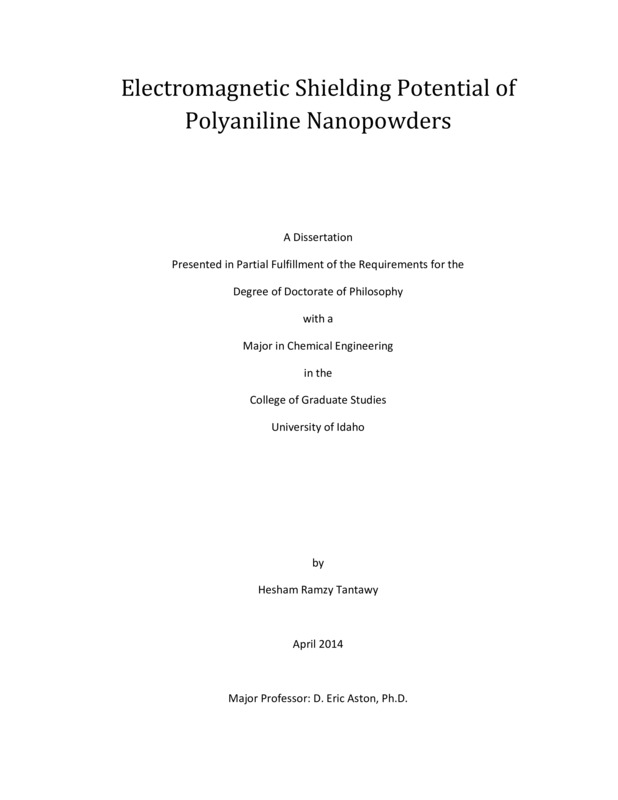Electromagnetic Shielding Potential of Polyaniline Nanopowders
Tantawy, Hesham. (2014). Electromagnetic Shielding Potential of Polyaniline Nanopowders. Theses and Dissertations Collection, University of Idaho Library Digital Collections. https://www.lib.uidaho.edu/digital/etd/items/tantawy_idaho_0089d_10034.html
- Title:
- Electromagnetic Shielding Potential of Polyaniline Nanopowders
- Author:
- Tantawy, Hesham
- Date:
- 2014
- Keywords:
- Conducting polymer Electromagnetic Shielding Polyaniline Shielding Effectiveness Solvent Free Solvent Limited
- Program:
- Chemical Engineering and Materials Engineering
- Subject Category:
- Chemical engineering
- Abstract:
-
.Electromagnetic (EM) shielding in the microwave range using conducting polymers is a unique contribution beyond the more typical synthesis and physicochemical characterization work of many others on polyaniline (PAN) and other well-characterized polymers. This is why a well-studied polymer base system with two different dopant candidates was selected for expanding knowledge beyond materials characterization into an application area of EM shielding. This work is significant due to the new and uncommon use of exceedingly-limited solvent during oxidative polymerization, which has demonstrated as an apparent optimum in conductivity and EM shielding for (somewhat surprisingly) moderate polymer crystallinity compared to conventional solvent-rich synthesis. Furthermore, it describes a rather simple and inexpensive solvent-free and solvent-limited methods capable of producing relatively large amounts of nanoparticles (<50 nm) in a fashion easily scaled for practical uses in composite materials for a variety of electrical and electronic applications. To the best of our knowledge, this is the first time electromagnetic shielding with polyaniline has been considered as a function of synthesis conditions comparing the so-called solvent-free/solvent-limited approach. Moreover, the most favorable synthesis approach to achieve the highest possible conductivity is a primary target for practical considerations in fine-tuning production on large scales. Therefore, the long-term goal of this research is the development of new light-weight and affordable high-frequency EM shielding materials from an eco-friendly fabrication method.
Experimental work demonstrates the chemical/electronic/conformational, structural, morphological and electrical characteristics of doped PAN nanoparticles from different chemical synthesis conditions. Detailed x-ray photoelectron spectroscopy (XPS), Raman, Fourier Transform-Infrared (FTIR), and ultraviolet (UV) spectroscopies were carried out for chemical analysis while transmission electron microscopy (TEM) and x-ray diffraction (XRD) were used for morphological and crystallinity characterization, respectively; a two-point probe technique was utilized for AC/DC electrical measurements, and EM shielding measurements used two different guided-transmission line techniques in the megahertz and gigahertz ranges. Results show that the nanopowders produced exhibit a range of EM shielding efficiencies for microwave radiation dependent on the average extent of oxidation, chemical/electronic/conformational structures, and electrical conductivity. Moreover, the effect of the synthesis approach and dopant type (species and organic/inorganic nature) on different physicochemical properties of the obtained PAN is elucidated. Collective data analysis demonstrates the importance of conductivity over crystallinity for enhanced shielding efficiency (SE) in nanoPANs doped with hydrochloric acid (HCl) and p-toluenesulphonic acid (PTSA). Furthermore, optimizing this new and unconventional approach for the best particular solvent-limited conditions (e.g., what is the optimum amount of solvent to maximize SE for a given dopant species) to well-defined polymer needs for conductivity and conformational structures shows inherent promise for future improvements toward various technological applications for made-to-order conducting polymeric materials.
- Description:
- doctoral, Ph.D., Chemical Engineering and Materials Engineering -- University of Idaho - College of Graduate Studies, 2014
- Major Professor:
- Aston, D. Eric
- Committee:
- McDonald, Armando G.; Admassu, Wudneh; Choi, Daniel S.; Elshabini, Aicha
- Defense Date:
- 2014
- Identifier:
- Tantawy_idaho_0089D_10034
- Type:
- Text
- Format Original:
- Format:
- application/pdf
- Rights:
- In Copyright - Educational Use Permitted. For more information, please contact University of Idaho Library Special Collections and Archives Department at libspec@uidaho.edu.
- Standardized Rights:
- http://rightsstatements.org/vocab/InC-EDU/1.0/

